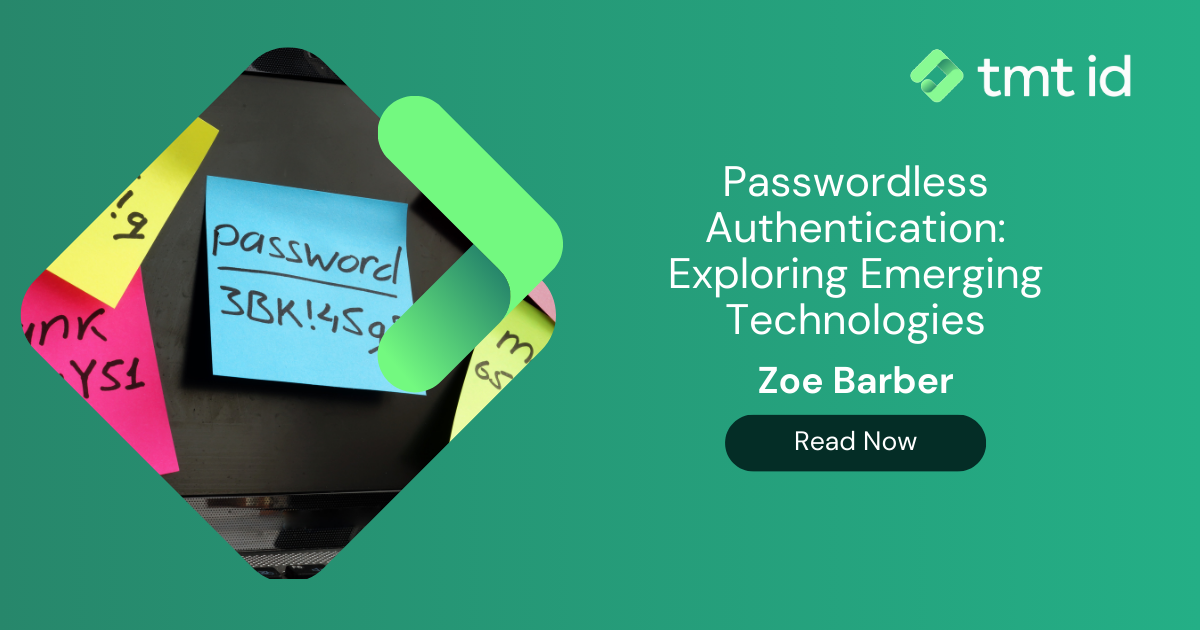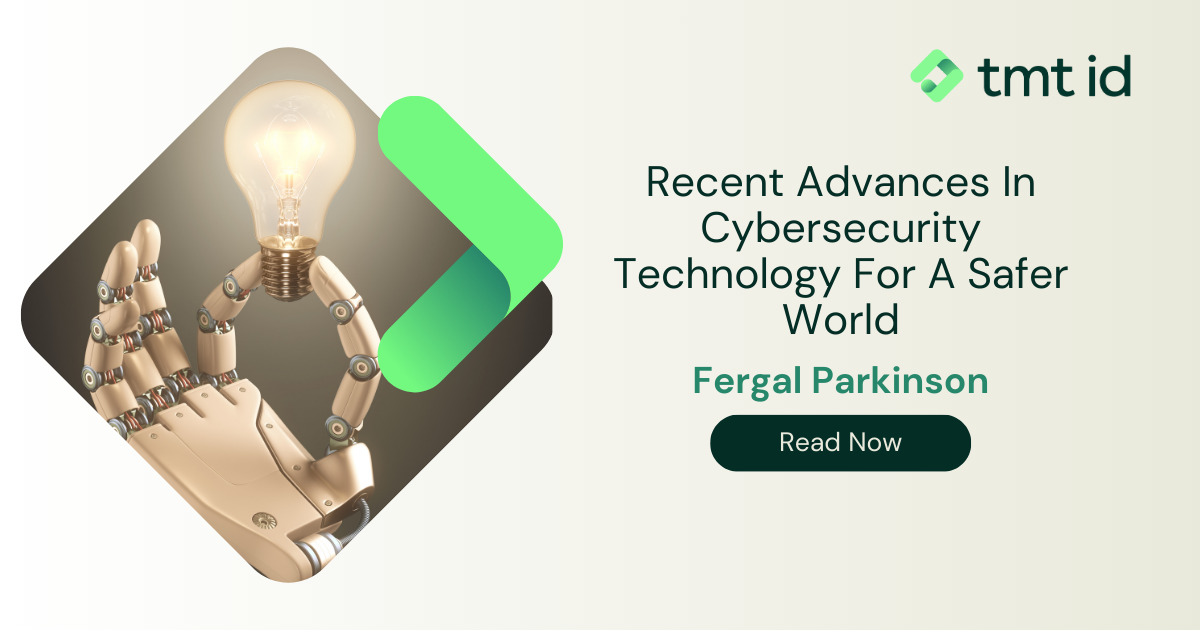
Authentication – “the process of verifying the identity of a user or device attempting to access a system, network, or application”
Authentication stands as our biggest obstacle against unauthorised access, fraud, and data breaches, so why do we struggle to stay ahead of the technological curve? As technology advances and cyber threats become more sophisticated, the need for authentication systems that offer greater security, as well as a seamless user experience is increasingly important.
The future is passwordless. Instead of requiring users to remember and enter complex passwords, passwordless authentication utilises biometrics (fingerprint, facial recognition, etc.), hardware tokens, or cryptographic keys. By eliminating the need for passwords, which can be easily forgotten, stolen, or compromised, passwordless authentication solutions reduce the risk of unauthorised access and account breaches.
This article will delve into the world of next-generation authentication and explore the emerging technologies that are revolutionising the field. We will discuss various cutting-edge authentication technologies, such as biometric, behavioural, multi-factor, passwordless, and blockchain-based authentication.
In today’s digital age, where cyber threats loom large, traditional authentication methods like passwords, PINs, and security questions have become the Achilles’ heel of online security. These time-tested methods, once considered the gold standard, are now riddled with limitations and vulnerabilities that leave individuals and organisations susceptible to data breaches, identity theft, and unauthorised access.
Passwords, once the go-to choice for authentication, have proven to be a weak link in the security chain. Users tend to create weak, easily guessable passwords or reuse them across multiple accounts, providing ample opportunities for attackers to exploit. Additionally, users struggle to remember complex passwords, leading to a proliferation of sticky notes or digital password managers that present their own security risks.
PINs, commonly used for authentication in banking and other sensitive areas, suffer from similar vulnerabilities. Simple and predictable combinations are often used, making them susceptible to brute force attacks. Furthermore, the limited number of digits in a PIN provides a narrow scope for variation, making it easier for hackers to crack the code.
The shortcomings of these traditional authentication methods are magnified by the rise of sophisticated hacking techniques and the increasing frequency of data breaches. With stolen passwords and compromised accounts being sold on the dark web, it is evident that a more robust and secure approach to authentication is desperately needed.
As individuals and organisations rely on digital platforms for communication, financial transactions, and sensitive information storage, the vulnerabilities inherent in traditional authentication methods present a clear and present danger. It is important that we explore and adopt next-generation authentication technologies to keep fraud levels at a manageable level.
GlobalData Patent Analytics have collected data on the rate of development for up and coming authentication methods – organised into emerging, developing, and maturing. In the emerging innovation stage, disruptive technologies such as byzantine fault-tolerant blockchain, secure multi-party computing, and decentralised identity frameworks are still in the early stages of application but show great potential. Accelerating innovation areas, including secure hash algorithms (SHA), zero-knowledge proofs, and private blockchains, have witnessed steady adoption. Meanwhile, well-established innovation areas like firmware security, multimedia signal encryption, silent network authentication, and biometric authentication are now maturing within the industry.
| Emerging | Accelerating | Maturing |
|---|---|---|
| Byzantine fault tolerant blockchain | Access theft detection | AES encryption |
| Decentralised identity framework | AI assisted network management | Biometric authentication |
| Elliptic-curve cryptography | Challenge-response authentication | Continuous authentication |
| Liveness detection | Contactless verification | Digital rights management (DRM) tools |
| Programmable electronic locks | Content paywall | Emergency communications network |
| Secure multi-party computing | Data security blockchain | Encrypted content distribution |
| Side channel attack mitigation | Decentralised identity | Firmware security |
| EMV tokenisation | Home automation network security | |
| Homomorphic encryption | Multimedia signal encryption | |
| Hybrid encryption algorithm | Perimeter security | |
| Keystroke analysis | Silent Network Authentication (SNA) | |
| Man in the middle (MITM) attack solutions | ||
| Multi-factor authentication | ||
| Mutual authentication protocols | ||
| Physical uncloneable functions (PUFs) | ||
| Private blockchains | ||
| Secure hash algorithms (SHA) | ||
| Signcryption | ||
| Software upgrade process | ||
| Software watermarking | ||
| Trusted platform modules | ||
| Trusted timestamping | ||
| User biometric authentication | ||
| VPN tunneling | ||
| Zero Knowledge Proof |
Biometric authentication, the cutting-edge technology that utilises unique biological or behavioural characteristics for identity verification, holds immense potential for enhanced security in today’s digital landscape. 3.6 million patents have been filed and granted in the technology industry in the past three years alone. By leveraging physical traits like fingerprints, facial features, or iris patterns, biometric authentication offers a highly secure and reliable method of verifying an individual’s identity. Unlike passwords or PINs, which can be forgotten, stolen, or guessed, biometric identifiers are inherent and unique to each person, making them extremely difficult to replicate or forge.
This makes biometric authentication an attractive solution for bolstering security measures, as it significantly reduces the risk of unauthorised access, identity theft, and account breaches. By harnessing the power of our own biological characteristics, biometric authentication is paving the way for a more secure and frictionless future, where individuals can confidently engage in digital transactions and access sensitive information with peace of mind.
Despite everything, biometric authentication does have some drawbacks. The potential for false acceptances and false rejections, where the system incorrectly grants access to unauthorised users or denies access to legitimate ones can cause serious problems. Privacy concerns also arise as biometric data, being unique and personal, raises questions about data protection and unauthorised access. Additionally, the inability to change or reset biometric traits in the event of a compromise poses a significant challenge. Furthermore, the implementation costs and infrastructure requirements can be substantial, limiting its adoption for organisations with limited resources.
Many industries are jumping on board. The financial services sector, for instance, has eagerly embraced biometrics, with banks and financial institutions incorporating fingerprint, facial recognition, and voice recognition technologies to bolster account security and facilitate seamless transactions. The healthcare industry has too, utilising unique identifiers such as fingerprints and palm vein patterns to ensure authorised access to confidential patient records. Furthermore, travel and transportation entities have revolutionised their operations by adopting biometric authentication for streamlined passenger screening, immigration processes, and boarding procedures, enabling smoother and more secure travel experiences. With applications ranging from government agencies leveraging biometrics for identity verification and border control to educational institutions implementing biometric passwordless authentication for access control and attendance tracking, industries are turning to advanced tech to enhance security, efficiency, and overall customer satisfaction.
Behavioural authentication has emerged as unique and innovative. Unlike traditional methods that rely on static credentials or biometric traits, it harnesses the power of individuals’ unique patterns and habits in their digital interactions. By analysing factors such as typing speed, mouse movements, touchscreen gestures, and navigation patterns, behavioural authentication creates a comprehensive profile of user behaviour. It offers a dynamic and context-aware authentication process, capable of detecting anomalies and unauthorised access attempts. With its ability to adapt and learn from user behaviour over time, behavioural authentication presents an intriguing solution that enhances security while providing a seamless user experience. As organisations seek advanced authentication measures, behavioural authentication is poised to play a significant role in mitigating risks and fortifying digital defences.
While behavioural authentication holds great promise, it also presents certain challenges that need to be addressed. One being the need for accurate and reliable behavioural data analysis. The system must accurately distinguish between legitimate user behaviour and fraudulent attempts. It requires advanced algorithms and machine learning techniques to continually adapt and learn from user behaviour, ensuring that authorised users are not falsely flagged as potential threats. Striking the right balance between effectively detecting security risks and minimising false positives is crucial to maintain user trust and satisfaction.
Behavioural authentication is being used already. For instance, financial institutions are leveraging it to detect fraud by analysing user behaviour for unusual patterns during online banking transactions. Similarly, e-commerce platforms are verifying users and preventing fraudulent activities during online purchases. In the healthcare sector, behavioural authentication is employed to safeguard patient records and ensure authorised access to sensitive medical information.
Multi-factor authentication (MFA) is where authentication goes beyond a traditional username and password combination to provide extra layers of protection. By requiring multiple factors, even if one factor is compromised, the chances of an attacker successfully bypassing the authentication process are greatly diminished. As cyber threats continue to evolve, adopting MFA is crucial for individuals and organisations to strengthen their cybersecurity. Any combination of different authentication factors can help protect users.
Mobile authentication leverages smartphones as an authentication factor, utilising features like fingerprint or facial recognition, or generating one-time passcodes through dedicated apps. Push notifications are also gaining popularity, allowing users to verify and approve login attempts directly from their mobile devices. Mobile network data allows you to instantly link a user to their device using cryptographically secure session data.
While we’ve already spoken about the issues with passwords, we’ve yet to mention an authentication method that requires no input. Silent Network Authentication (SNA) or ‘phone number authentication’ is an innovative method of ensuring secure consumer authentication while eliminating the need for users to wait or exit their application. It leverages direct carrier connections to verify ownership of a phone number in the background, without requiring any input from the user. With SNA, there is no reliance on 6-digit passcodes or the need to download an authenticator app, making it highly resistant to phishing attempts and immune to social engineering attacks. This user-friendly solution maintains a seamless experience while providing robust protection for end-users, accounts, and transactions.
SNA is built upon the existing authentication infrastructure that carriers use to authenticate mobile phone calls and data sessions, providing a high level of assurance for each verified phone number. While the underlying authentication system is standardised and widely trusted, extending this type of authentication to businesses through APIs like Number Authenticate is a relatively new development. An example of it in use would be Facebook. Facebook utilises SNA through its Account Kit feature. It leverages the user’s mobile phone number to verify their identity in the background, enabling seamless login experiences for users without requiring additional input or authentication steps.
Hardware tokens and FIDO2 standards also require no input. Hardware tokens are physical devices that generate one-time passwords or cryptographic keys, providing an additional layer of authentication beyond traditional usernames and passwords. FIDO2 (Fast Identity Online 2) standards are a set of specifications that enable passwordless authentication using public-key cryptography. FIDO2 eliminates the need for passwords and relies on secure hardware tokens or biometrics to verify user identity. A major advocate for hardware tokens is Google. They require employees to use them for two-factor authentication. They developed their own hardware key called the Titan Security Key, which provides an extra layer of security for accessing Google’s internal systems and services.
Blockchain technology holds immense potential for transforming authentication processes by providing a decentralised and secure framework. Unlike traditional methods that rely on centralised authorities, blockchain offers a distributed ledger where identity information can be stored and verified. By recording users’ credentials and personal details in encrypted digital identities on the blockchain, authentication becomes tamper-resistant and resistant to single points of failure.
The decentralised nature of blockchain ensures that no single entity has control over the authentication process, fostering trust and reducing the risk of data breaches. Moreover, blockchain authentication enables self-sovereign identity, empowering individuals with ownership and control over their personal information. As this technology continues to evolve, it has the potential to revolutionise authentication, offering enhanced security, privacy, and user-centricity in the digital realm.
However, implementing blockchain-based authentication is not without its challenges. One major concern is scalability, as blockchain networks may struggle to handle a large volume of authentication requests efficiently. Ensuring seamless and prompt authentication for a growing user base will require technological advancements and innovative solutions to overcome these scalability limitations. Additionally, striking the right balance between transparency and privacy is crucial, as blockchain’s inherent transparency must be reconciled with the need to protect sensitive user data. Moreover, managing private keys securely and educating users about their responsibility in safeguarding their keys will be essential to prevent the loss or theft of identities.
The field of authentication continues to be a hotbed of research and development. Advancements in machine learning and artificial intelligence are being leveraged to develop behaviour-based passwordless authentication methods, analysing user patterns and interactions to verify identities. Additionally, the integration of blockchain technology in authentication systems is gaining traction, offering decentralised and tamper-resistant identity verification. As the digital landscape evolves and threats become more sophisticated, ongoing research and development efforts are poised to revolutionise authentication, ensuring secure access to our accounts while prioritising user convenience and privacy.
These developments are not a silver bullet. Privacy concerns arise as the collection and storage of sensitive user data increase, requiring robust safeguards to protect personal information. Scalability remains a hurdle, with authentication systems needing to accommodate growing user bases and handle a large volume of requests without sacrificing efficiency. Moreover, user acceptance is crucial, as individuals may be hesitant to embrace new authentication methods, emphasising the importance of user-friendly interfaces and transparent communication about the benefits and security of these systems. Overcoming these challenges will be pivotal in ensuring that future authentication solutions strike the right balance between privacy, scalability, and user acceptance, fostering a safer and more user-centric online world.
Authentication stands as our biggest challenge in the face of the evolving technology involved in cyber threats. Traditional methods like passwords and PINs are proving inadequate, thrusting the identity sector towards innovation. The future of authentication lies in passwordless approaches, leveraging biometrics, hardware tokens, silent network authentication and blockchain technology. These advancements offer enhanced security and a seamless user experience, addressing the vulnerabilities of traditional methods.
Challenges such as privacy concerns, scalability, and user acceptance must be overcome for successful implementation. Ongoing research and development in the field, driven by advancements in machine learning and artificial intelligence, hold the key to revolutionising the way we verify identities and protect our digital lives. As we navigate the ever-changing landscape, striking the right balance between security, convenience, and user privacy will be crucial to ensure a safer and more user-centric online environment. It is time to leave behind the limitations of traditional authentication methods and embrace the future of authentication. By doing so, we can create a more secure, efficient, and trustworthy digital world for everyone.
Although authentication is primarily designed as a security measure, customer experience plays a considerable role, and must not be ignored when choosing what is suitable for you. How likely is your customer to continue their journey or transaction with high levels of friction? How much custom will this cost you every month? Is there a way to increase security without increasing customer friction?
Mobile Network Operator (MNO) data has become a necessary part of businesses’ authentication, onboarding, and fraud prevention strategies due to its high-trust and authoritative nature. The data held by the MNOs can be matched with user-provided information – all that is required is a mobile phone number. Such data include name, age, date of birth, and address.
Furthermore, companies such as TMT can enhance the verification of a user’s identity by giving confidence that the SIM card and device being used in real-time belong to the mobile number provided. A silent device session check can even make the OTP and password redundant.
Authentication doesn’t have to be expensive and frustrating. We built an easy-to-use framework which integrates into your existing systems, hassle-free. Our API gives you immediate access to vital data insights surrounding a mobile number and the device attached which are used to instantly authenticate a user.
Giving you confidence in device possession.
By adding MNO data to authentication strategies, companies are increasingly being able to go password-free, improving both security levels and customer satisfaction.
To find out more about bringing MNO data into your business, book a free, introductory call. We would love to help you identify and authenticate customers.
Alternatively, find out more about MNO data through our blog, or sign up for our mailing list in the footer below.
Last updated on March 28, 2024



We provide comprehensive device, network and mobile numbering data available.
Contact us > Chat to an expert >